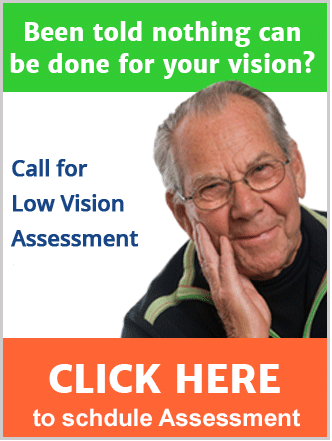LOW VISION SOLUTIONS
Magnification

One of the most common solutions used to help people see more clearly is to use magnification. Simply, make what you want to see bigger. Most people who have a visual impairment have holes or distortion in their vision making small objects or print difficult to see. By making the object or print bigger, the holes or distortion becomes less visible.
There are three ways to magnify:
- Use Large Print products.
These large print products include large print books, large print keyboards and computer software, TV remote controls, clocks, and playing cards.
- Move closer to what you want to see.
Simply moving closer to the television or sitting in the front row in a movie theater or other event will significantly increase the size of what you wish to see.
- Use products that magnify.
Use magnification products such as strong reading glasses, hand magnifiers, telescopes and video magnification systems. Eyeglasses can be made up to 20X power and electronic magnification systems can magnify up to 84X.
These large print products include large print books, large print keyboards and computer software, TV remote controls, clocks, and playing cards.
Simply moving closer to the television or sitting in the front row in a movie theater or other event will significantly increase the size of what you wish to see.
Use magnification products such as strong reading glasses, hand magnifiers, telescopes and video magnification systems. Eyeglasses can be made up to 20X power and electronic magnification systems can magnify up to 84X.
Video Magnifiers
A video magnifier is a form of electronic magnification. A camera is directed at an object and the image is projected on a computer monitor or attached screen. A person reads by placing the reading material under the camera. The letters are projected onto the computer screen without distortion.
Video magnifiers come in portable and desktop models and are the easiest low vision aid to use when a person needs greater than 3X magnification. A visually impaired person can read, look at recipes, do paper work , look at pictures, cut their finger nails, knit, and perform many tasks easily with this low vision aid. Some video magnifiers have movable cameras that allow a person to see near objects and can also be used to see the television, board in the school room and other distance tasks
Hand and Stand Magnifiers
Magnifiers come in many styles and powers, and are useful for reading or performing other near tasks. It is common to hear patients say that they have tried magnifiers in the past and that they simply do not work. Using the wrong power magnifier is similar to wearing the wrong prescription in your eyeglasses, you will not see clearly. A good selection of magnifiers can only be found by professional low vision assessment exam. Here the correct power magnifier needed to perform a task is determined and the patient is taught how to use the magnifier correctly.
Low Vision Reading Glasses
Low vision eyeglasses are one of the most commonly prescribed low vision aids for reading. Usual reading adds up to +2.50 to +3.50 Diopters will not work for a person who is considered to have low vision. So, special reading glasses and bifocal lenses in powers up to +80 Diopters or specially mad reading glasses are required for hand-free reading.
Tele/microscopes
Spectacle or eyeglass mounted telescopes can be made to focus at any working distance. Compared to strong reading glasses, a tele/microscope allows a person to work at a more normal working distance. This can be important when viewing the computer screen, knitting, playing music or when or performing any task that is uncomfortable when done at a close distance. Tele/microscopes are mounted on an eyeglass frame to keep hands free while performing the near task. These glasses are similar to the tele/microscopes that surgeons and dentists use.
Solution for watching TV

Specially made TV glasses are available. These hands-free, head-mounted glasses provide 2.1x magnification. The glasses will focus on objects from distances of 3 m to infinity, and are perfect for watching TV, sporting events, movies, theatre, bird watching, or any other distance viewing activity in which a magnified image would be helpful.
Glare Control















